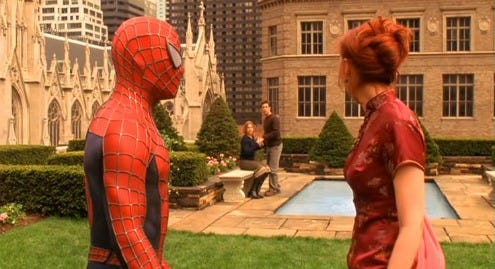The Marvel Movies: Spider-Man (2002)

Like Roger Corman's "Fantastic Four," it's hard to explain the build-up to the "Spider-Man" film to non-fans and young people. As Marvel's most popular, most relatable character, Peter Parker stood at the center of what was for years the most sought-after property in the world.
And for proof, look at the years of legal wrangling over Spidey's movie rights. Marvel, in financial trouble, sold off the movie rights to many of its characters, including Spider-Man, which resulted in lawsuits between various entities interested in one day making a Spider-Man movie. For more than a decade, Spidey's rights were tied up in court while suits hashed out who would make the movie.
At one point, James Cameron was attached to it in the '90s; at one point, fanboys envisioned Charlie Sheen pulling on the Webhead's suit. Spidey could have had radioactive tiger blood!
In the end, it was Sony/Columbia and Sam Raimi who made the film, and it was Tobey Maguire who inhabited Parker's psyche.
Then there was the little matter of how to properly capture Spider-Man in action. Swinging between skyscrapers on webs had been attempted before (in the '70s-era Spider-Man TV movies) but mostly to unconvincing results. The new millennium brought with it cutting-edge special effects, which even in 2002 couldn't completely support Spidey's visual needs. (Web slinging wouldn't be perfected until the two sequels.)
Instead, Raimi focused on Peter for the film's first half, then used a few camera tricks to mask the technology's shortcomings.
Raimi also, to some consternation from the fanboy community, tinkered with Spidey just enough to upset the peanut gallery, subbing Mary Jane Watson (Kirsten Dunst, never fully up to the role) for Spidey's true love, Gwen Stacy (would would make an appearance in the third film as subplot filler for Pete), and jettisoning the comic's mechanical web shooters (which Parker invented along with his webbing) in favor of "organic" shooters (i.e., his body created web fluid which shot directly from his wrist).
Then we come to the big-guy's nemesis, Norman "Green Goblin" Osborn (Willem Dafoe). Raimi threw him in green armor, prompting fans to derisively refer to him as "Power Ranger Goblin." Raimi also, mostly through editing, failed to accurately capture Parker's relationship with Osborn, especially given the complication of Norman's young son, Harry (James Franco), as Pete's best bud. Their conflict is never allowed to fully dominate the film, what with all the romantic triflings with MJ. (This includes a nonsensical resolution to the love triangle created when Harry starts dating her. Pete looks like quite the cad when he steals her away; not that Harry seems to mind all too much.)
Raimi none-too-subtly uses color to get his point across, outfitting Norman in Spidey's signature red and blue while Peter is often clad in green. It's supposed to represent their love-hate relationship, but we never get an indication from the film that he's anything more than an acquaintance.
Raimi also eschews Spidey's sarcasm, a comic-book staple, choosing to make him more of a to-the-bone nerd. That's another lesser quibble that doesn't become an issue until later in the franchise when all of Raimi's flaws are magnified.
Still, Raimi pleased overall, offering audiences the utter thrill of seeing Spider-Sense realized on the big screen, Flash Thompson picking on Peter, J. Jonah Jameson (J.K. Simmons in the first of three brilliant performances in this series) demanding more Spidey pictures and, finally, the Webhead gliding between buildings. Plus, the famous upside-down kiss between Spidey and MJ is a classic moment.
And the tussles between Spider-Man and the Goblin still range from solid to spectacular, even after seeing the stakes rise in the two sequels. However, Raimi does tone down the stakes of their final battle just a touch. (In the comics, the same battle ends with Gwen dead by the Goblin's hands, but the film, to the displeasure of some of the haters, let MJ survive the scenario in which Gwen perished.)
The acting is hit-or-miss. Dunst is wishy-washy at best, and Franco was pretty bad throughout the series. Dafoe hams it up playing an insane "dual" role, mostly to great effect.
The editing is also spotty; at worst, it's distractingly bad, and the final cut features conversations with unnatural transitions, abrupt changes of subject and uneven, choppy action sequences.
Being a movie set in New York circa 2002, there are also a few post-9/11 tributes — from Spidey on a flagpole, the American flag waving above him, to an assist from New Yorkers in the finale (with the "You mess with one of us, you mess with ALL of us!" mantra on display, which Raimi promptly lampooned in the second film).
Recall also that the initial "Spider-Man" teaser trailer featured bank robbers escaping in a helicopter only to be caught in Spidey's web between the Twin Towers of the World Trade Center, and the film's teaser poster featured the towers reflecting in Spidey's eye.
But still, "Spider-Man" does enough, with a nerdy charm, a sense of wonderment and humor, and geeky essence, to prepare us for the greatness to come.
Next time: Give it up for 'ol Hornhead!
Previous Marvel Movie Entries
Conan the Barbarian (1982) Conan the Destroyer (1984) Red Sonja (1985) Howard the Duck (1986) The Punisher (1989) Captain America (1990) The Fantastic Four (1994) Blade (1998) X-Men (2000) Blade II (2002)


